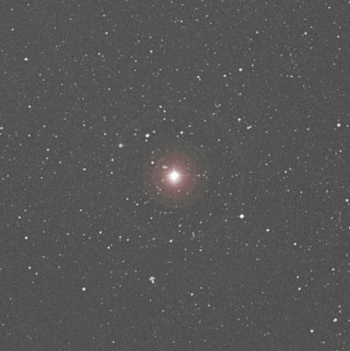
Image Source.
When I give a public lecture, I often start by trying to impart a sense of the extraordinarily rarefied character of the local galactic neighborhood. The known catalog of planet-bearing stars is akin to 200 small grains of sand dusting a volume more than 1000 kilometers on a side. It seems amazing to me that we’re able to see the stars at all with the naked eye. Even Sirius appears twelve billion times fainter than the Sun.
At the moment, the Alpha-Proxima trio is the closest group of stars to the Sun, and they are currently drawing closer still. In 27,000 years, they will pass at a minimum distance of 2.75 light years. Already, the Alpha-Proxima system is beginning to have an effect on the Oort Cloud, and as a result of the encounter, roughly half a million comets will be delivered into Earth-crossing orbits over the next several million years. This will generate something like a 10% increase in the arrival of new comets above the long-term average.
In 1999, Joan Garcia-Sanchez and collaborators filtered the known space motions of nearby stars in order to determine which systems are scheduled to make (or have already made) close encounters with the Solar System. The closest approach that they identified belongs to the currently inconspicuous red dwarf Gliese 710. In 1.4 million years, this half-solar mass star will skim by at a distance of ~1.09 light years, and will appear as bright and as red in the night sky as Betelgeuse. Like most low-mass stars in the galactic disk, Gliese 710 probably has a retinue of terrestrial planets. If the encounter were occurring now, Gliese 710 would likely have both an evocative Arabic name, as well as hundreds to thousands of high-precision radial velocity measurements.

The Gliese 710 encounter will produce a comet shower roughly six times more severe than what Alpha and Proxima will generate. It’s unlikely, however, that the increase in the number of comets will lead to an extinction-level impact. Nevertheless, the impending passage of a red dwarf at a distance of only 70,000 AU has a certain panache.
Given that encounters of the Alpha-Proxima and Gliese 710 variety are occurring on a million-year timescale, what is the most hair-raising encounter that one can one expect on a 4.5-billion year time scale? The mean encounter velocity between stars in the galactic disk is of order 40 kilometers per second, and the density of stars is ~0.1 systems per cubic parsec. Using these numbers, a simple n-sigma-v calculation yields an expected close-approach distance of only 770 AU. An encounter this close would literally thread the orbits of outer solar system bodies such as Sedna.
Imagine waking up to one of two headlines: (1) “Red Dwarf Discovered heading straight toward the Solar System at 400 meters per second!” and (2) “Red Dwarf Discovered heading straight toward the Solar System at 40 kilometers per second!”
Naively, one might expect that headline #2 bears much worse news, but surprisingly, that’s not the case. A red dwarf passing through the outer Solar System at 40 kilometers per second would barely deviate from a straight-line trajectory. Aside from any comets or Kuiper belt objects lying nearly directly in its path, it would barrel past us and produce only a minimal perturbation to the planetary orbits. Headline #2, on the other hand, could potentially be very bad news, as a close encounter with a slowly moving star can be far more damaging. The reason is that the interloping star is in the vicinity for much longer, and has time to build up a far stronger overall perturbation on solar system bodies. When the solar system was forming, the Sun very well could have belonged to an open cluster like the Orion Nebular Cluster. In a cluster environment, a close (several hundred AU) passage of a slowly moving brown dwarf or a low-mass star is a fairly common event, and indeed (as argued here by Morbidelli and Levison) the Sun may well have grabbed Sedna and a few hundred other as-yet undiscovered dwarf planets from an interloping star.
Asteroids that hit the Earth routinely kick clouds of debris into interplanetary space. Large rocks launched in this fashion can harbor hardy bacteria for nearly indefinite periods of time. The outer solar system, then, at any given moment, is often sparsely populated by viable dormant spore-forming bacteria that originated on Earth (see, e.g. here).
Odds are, that once-in-the-solar-lifetime (~770 AU) close encounter involved a red dwarf as the interloping star. A run-of-the-mill red dwarf has 0.3 solar masses and 1% of the solar luminosity. A habitable orbit around such a star lies at a distance of ~0.1 AU, and orbits at a speed of ~50 kilometers per second. This orbital velocity is quite close to the ~40 kilometer per second relative velocity that one would expect for an interloping star at our galactocentric radius. This means that the existence of a habitable terrestrial planet would have given the impinging parent red dwarf a dynamical mechanism for absconding with some of the material that belonged to our own outer solar system. Comets, rocks, and dwarf planets captured in this way would have stuck with the red dwarf, orbiting until they either collided with or were ejected by the red dwarf’s planets.
When that first SETI signal gets picked up, it’s unlikely, but not impossible that it’ll be coming from my trillionth cousin five hundred billion times removed.
